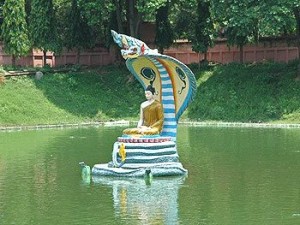Our Gautama Buddha was 35 years when he attained Buddha Hood.
For seven weeks after attaining the Enlightenment, our Gautama Buddha spent under, and in the vicinity of, the ‘Sri Maha Bodhi Tree’ (the peepul tree came to be known thus, as a result of giving shelter to Ascetic Gautama to attain Buddha hood; ‘Bodhi’ meaning ‘Enlightenment”), reminiscing about the Buddhist canon (Dharma), meditating and relaxing in the ultimate peace.

Gautama Buddha spent time under the Sri Maha Bodhi tree
In the first week, our Gautama Buddha spent time under the Sri Maha Bodhi tree just the way he attained Enlightenment; sitting cross-legged going through the exhilaration of finding the ultimate solution to end the suffering. He enjoyed the pleasure of liberation the entire week. By the end of the week, he had methodically contemplated, in the direct and the reverse orders, on the “Dependant Origination” (Patikkha Samuppada) & “Cause and Effect”.
During the second week, he stood facing the Sri Maha Bodhi tree, gazing at it without blinking, to show his gratitude for giving him shelter to attain Buddha hood. (This is the first moral lesson Buddha taught the world silently, only with his action; GRATITUDE)
Gautama Buddha saw from his divine eye that some gods in the heavenly planes were not sure about his Enlightenment since he was still living under the Bodhi tree. Therefore, he created a golden bridge in the air and walked up and down on it for a whole week to convince them, contemplating his new found knowledge all the time.
In the fourth week, Gautama Buddha created a jeweled chamber on to the North Western direction of the Sri Maha Bodhi tree and sitting inside, started to reflect on the seven expositions of “Abhidhamma” (Higher doctrine).
Contemplation on the first six expositions did not feel weighty, intense or sensitive to the intellectual mind of the Gautama Buddha and he didn’t feel much happiness by reflecting upon them. But the seventh exposition was profound and difficult; when our Buddha started to contemplate it, his wholesome mind started to move freely bringing him happiness akin to the exhilaration a bird feels when released from its cage. Gautama Buddha’s blood was cleansed, bringing his whole body to a luminescent state. Light emitted from his body akin to a fire. Blue rays were released from his hair and bluish places of his eyes; from the skin & the yellowish places of the eyes, emanated the yellow rays; red rays were produced from his blood, flesh and reddish places of his eyes; white rays were emitted from his bones, teeth and the whitish places of his eyes; when all these colours blended, the orange colour was formed.
These colours are used in the Buddhist flag which was designed in 1885 by the “Colombo Committee”, Colombo, Sri Lanka. Each colour symbolizes one or more noble qualities of our Buddha;
Blue – Loving Kindness, Peace & Universal Compassion
Yellow- The Middle Path
Red- The Blessings of Practice – accomplishment, wisdom, morality, prosperity & nobility
White- The purity of Dhamma
Orange- The Buddha’s teachings

Buddhist Flag

.
In the fifth week, our Gautama Buddha spent his time seated cross-legged immersed in the ‘Bliss of Liberation’ (Vimukthi Sukha) under a banyan tree known as ‘Ajapala’ in the vicinity of the Sri Maha Bodhi tree. A very proud Brahmin, who was passing by, stopped near our Buddha and inquired regarding the qualities of a true Brahmin. Our Gautama Buddha said that a person could be called a real Brahmin if he is rid of evil traits, pride & attachment with worldly life; is learned, self restrained & spotless and follows a holy path.

The serpent king ‘Muchalinda’

The serpent king ‘Muchalinda’
At the beginning of the sixth week, it started raining heavily. The serpent king ‘Muchalinda’, from the nearby lake of the same name, came and coiled himself around the Buddha and provided shelter with his huge hood. For the entire seventh week, our Gautama Buddha meditated under the Serpent’s protection near the lake.
During the seventh week, Gautama Buddha spent under a type of banyan tree named Rajayathana, meditating. At the end of the week, two wandering merchants, Thapassu & Balluka offered roasted rice (similar to popcorn) & bees’ honey to our Gautama Buddha becoming the first devotees taking refuge in Buddha & his teachings (Two Jewels since the Sangha clan had not been established by that time).

Girihadu seya
They were given a handful of his locks by the Buddha for veneration, which they deposited in a jeweled canister. The two merchants took this canister everywhere they went and paid great reverence to it. In Heladiva (Sri Lanka), they had slept keeping the canister on a rock for its protection. The following morning, before resuming their journey, they had tried to take the canister from the rock to no avail. It had stuck on the rock. Thapassu & Balluka knew that it was the right place for it and made a mound with soil and stones covering the canister, which became the first stupa in the world. It was given the name “Girihadu Seya”. It has been renovated along the centuries by various kings and still stands on top of a rock with beautiful surroundings at Thiriyaya in the Trincomalee District, Eastern Province of Sri Lanka.
Our Gautama Buddha was disheartened when he considered teaching his new found, complicated spiritual discoveries, to the people who were full of defilements. But, his divine eye made him realize otherwise. This made him accept Maha Brahma Sahampathi’s request to preach his teachings to the world.

.
His first consideration was his former teachers Alara Kalama & Uddakaramapuththa. But, they were dead by that time. Therefore, he went in search of the five ascetics who helped him during his six years of self-starvation to the Deer Park atIsipathana in Benares (Present day Saranath at Varanasi on the Western Banks of river Ganges in Uttar Pradesh, India).
The ascetics, seeing Gautama Buddha approach them, decided to ignore him. They thought that he was coming for their help again since he had failed to attain the Enlightenment.

.
They showed disinterest when Gautama Buddha explained his new found knowledge and hesitated to believe that he had attained Buddha-Hood. But when our Buddha kept on expounding the Four Noble Truths earnestly, they could not reject him anymore. Thus, Gautama Buddha gave his first sermon “Dhamma Chakka Pawaththana Sutta” which meant ‘setting in motion the wheel of Dhamma’, regarding the Four Noble Truths, which was the essence of Buddhism. At the conclusion, Kondanna attained ‘Sothapaththi’ (Stream Enterer), the first step towards Enlightenment.
Impressed by the Buddha’s teachings, they became the first ordained monks of our Gautama Buddha’s Order. Bhaddiya, Wappa, Mahanama & Assaji too attained ‘Sothapaththi’ following Buddha’s advice. All of them attained Enlightenment (Arahanth hood) after hearing the “Anantha Lakkhana Sutta” (Philosophy of soullessness). Millions of beings from the heavenly planes too attained Enlightenment hearing Buddha’s sermons.